Abstract
Human exposure to BPs is inevitable mostly due to contaminated food. In this preliminary study, for the first time, the presence of bisphenols (BPs) in aqueous humor (AH) collected from 44 patients undergoing cataract surgery was investigated. The measurements were performed using a sensitive ultra-high performance liquid chromatography-tandem mass spectrometry (UHPLC–MS/MS). Chromatographic separation was achieved using a reverse-phase column and a gradient elution mode. Multiple reaction monitoring (MRM) was used. The method was validated for bisphenol A (BPA) and bisphenol F (BPF). The limits of quantification (LOQs) of both investigated analytes were 0.25 ng mL−1. The method was linear in the range of 0.25–20.0 ng mL−1 with correlation coefficients (R2) higher than 0.98. Recovery of analytes was in the range of 99.9 to 104.3% and intra-assay and inter-assay precision expressed by relative standard deviations (RSD%) were less than 5%. BPA was detected in 12 AH samples with mean concentrations of 1.41 ng mL−1. BPF was not detected at all. Furthermore, two structural isomers termed BPA-1, and BPA-2 were identified, for the first time, in 40.9% of the AH samples, with almost twice higher mean concentrations of 2.15 ng mL−1, and 2.25 ng mL−1, respectively. The total content of BPs were higher in patients with coexisting ocular pathologies such as glaucoma, age-related macular degeneration (AMD), and diabetes in comparison to cataracts alone. However, the difference between these groups did not reach statistical significance (p > 0.05). Performed investigations indicate the need for further research on a larger population with the aim of knowing the consequences of BPs’ accumulation in AH for visual function.
1. Introduction
The aqueous humor (AH) of the eye is the fluid located in the anterior chamber of the eye. Despite the fact that the volume of AH is very small and in humans it amounts to about 0.3–0.5 mL, it is necessary for the proper functioning of the vision organ. AH is formed by diffusion and ultrafiltration of plasma; however, the composition of the fluid is modified due to the secretion of the unpigmented ciliated epithelium [1,2,3]. The composition of AH includes immunoglobulins, neuropeptides, proteins, lipids, carbohydrates, enzymes, vitamins, and microelements. Previous studies are usually devoted to the search for the relationship between the composition of AH and various eye diseases such as age-related macular degeneration (AMD), cataracts, diabetic retinopathy (DR), glaucoma, etc. [4,5,6]. Most of these works concern the analysis of cataract progression. For this purpose, the composition of amino acid and lipid metabolites such as glutaric acid and pelargonic acid [7], markers of lipid peroxidation [8], enzymatic antioxidants such as superoxide dismutase (SOD) and catalase (CAT) [8], and tryptophan metabolites [9] were investigated. Due to the small amount of material for research, restrictions related to research on humans, and trace amounts of analytes in AH, advanced analytical techniques are used for analysis, such as nano-LC-ESI-MS/MS [10], ultra-high-performance liquid chromatography coupled with triple quadrupole mass spectrometry with electrospray ionization (UHPLC-ESI-MS/MS) [9], ICP-OES [11], ICP-MS [12].
AH analysis has not yet been fully utilized in the diagnosis of eye diseases. There is a lot to be investigated, for instance in the area of xenobiotic risk or environmental toxin exposure assessment in the context of searching for causes of visual impairment. So far, there are no studies on the search for bisphenols (BPs) in AH. It is known that there are many sources of exposure to these environmental toxins as they are widely used in the production of polycarbonate plastics and epoxy resins [13]. The most common of them is bisphenol A (BPA; 4,4′-isopropylidenediphenol). BPA migrates to the environment as evidenced by reports of its detection in various environmental matrices such as soil, water, air, and plants [14,15]. Human exposure to BPA occurs primarily through the oral route, via food and drink packed in plastic containers. However, there is the possibility of exposure to BPs by transdermal or inhalation routes. Due to high lipophilicity (log P = 3.4), BPA can easily cross biological barriers such as blood–placental and blood–brain [16]. As a result of constant exposure, humans may accumulate BPA in tissues from which it is gradually released [17]. Previous studies have shown that BPA can be accumulated in the brain, causing toxic effects [18] that manifest as nervous and behavioral disorders, impairment of visual memory (object recognition) and spatial memory (object localization) [19]. Unfortunately, the neural function of BPA, particularly at the level of the visual neurons, remains poorly understood. The presence of BPA has been detected in human blood. However, the obtained results differ from each other depending on the patient’s living place. The mean serum level in Japan was in the range of 0.33 to 0.59 ng/mL (n = 20) [20], whereas in Hong Kong it was 0.95 ng/mL (n = 153) [21].
To measure BPs in biological matrices, different analytical techniques are applied. Some of them are immunochemical techniques such as, e.g., enzyme-linked immunosorbent assay (ELISA) used for the determination of BPA in serum samples [22,23]. However, this test is characterized by low sensitivity and specificity due to the high probability of interaction with interfering substances present in the matrix [22]. The commercially available kit for the determination of the content of BPA in biological samples has a measurement range of 0.3–100 ng/mL [24]. Gas chromatography coupled with mass spectrometry (GC-MS) is frequently used for the determination of BPA in various types of matrices. Due to its low volatility, BPA requires derivatization with acetic anhydride, N-O-bis (trimethylsilyl) trifluoroacetamide (BSTFA), pentafluorobenzyl bromide (PFBBr), or 4-(4,5-diphenyl-1-imidazoyl chloride) benzoyl (DIB-Cl) [25]. High-performance liquid chromatography (HPLC) is also used for the determination of BPA. HPLC can be combined with various detectors such as: spectrophotometric (UV-Vis, ultraviolet-visible detector) [26], fluorescent (FLD, fluorescence detector) [27], electrochemical detector (ED) [28], mass spectrometer [29], or the tandem mass spectrometer (MS/MS) [30]. BPA was determined in various biological matrices, e.g., serum [31,32], urine [33,34,35,36,37,38,39], food [28,40,41,42], amniotic fluid [43,44,45], breast milk [46].
Many studies have demonstrated the toxic effects of BPs on human health. It should be remembered that BPA is an endocrine-disrupting compound (EDC). That is why human exposure to BPA affects reproduction [47], thyroid function [48], hypertension, diabetes, and obesity [49,50]. According to the United States Environmental Protection Agency (US EPA), the acceptable BPA dose is 50 µg/kg body weight/day [51]. The World Health Organization (WHO) estimated the average consumption of BPA present in food products to be <0.04–0.40 µg/kg/day, and in the worst case this value could be 1.40 µg/kg [52,53]. Since BPA is detected in the urine of most people, there is no doubt that exposure to this compound is common today.
In literature, there are no studies confirming the involvement of BPA in human eye pathology, although it is known that BPA intoxication is associated with high blood pressure (HBP) [54], which is one of the key factors in retinopathy. Akintunde, et al. [55] used BPA as an agent of ocular impairment in a rat model to explore ocular protein aberration and its associated cataract. Another study is the work of Xu et al. [56] describing the disturbance of the visual function of cats, through the disruption of individual activity of neurons and the processing of visual information in the primary vision path as a result of exposure to BPA. The authors of the study suggest that BPA-induced degeneration of visual perception is the result of changes in the subcortical regions. Evidence of this claim is the increased expression of phosphorylated regulated extracellular kinase (ERK) observed in BPA-exposed neurons [57]. ERK is considered to be a factor that influences the modulation of synaptic vesicle mobilization and the triggering of the excitatory transmitter [58].
In our preliminary study, an attempt was made to quantify BPA and bisphenol F (BPF) in the AH samples collected during cataract surgery. BPF is a BPA analog also belonging to endocrine-disrupting compounds. BPF is widely used as an alternative to BPA in the production of various products such as food packaging, sealants, and dental composites. The analysis was performed by UHPLC/MS/MS and included 44 patients. To the best of our knowledge, this is the first attempt to determine BPs in this biological material.
2. Materials and Methods
2.1. Standards and Solvents
The bisphenols’ standards: 2,2-Bis(4-hydroxyphenyl)propane-d16 (Bisphenol A-d16, (IS)), 4,4′-methylenediphenol (bisphenol F—BPF), 2,2-Bis(4-hydroxyphenyl)propane, 4,4′-Isopropylidenediphenol (bisphenol A, BPA) were obtained from Sigma-Aldrich (Bellefonte, PA, USA). Methanol (MeOH), isopropanol (iso-PrOH), and formic acid (HCOOH) of LC-MS grade were purchased from E. Merck (Darmstadt, Germany). LC-MS grade water was purchased from Sigma-Aldrich (St. Louis, MO, USA). All analytical solvents and types of equipment were checked for BPs’ contamination prior to experiments. Individual stock standard solutions were prepared in methanol and stored in screw-capped glass tubes in a refrigerator (+4 °C) under the same conditions for up to two weeks.
2.2. Sample Collection
The AH samples were taken from the patients undergoing surgical procedures, namely, cataract phacoemulsification in the Chair and Department of General and Pediatric Ophthalmology, Medical University of Lublin. The study was approved by the Local Bioethical Committee of the Medical University of Lublin (approval no. KE-0254/154/06/2022). Aqueous fluid extraction was performed at the microscope through paracentesis at the first stage of the cataract removal procedure. A 27- or 30-gauge needle was used, with the extraction of 0.1 to 0.2 mL of AH followed by injection of a balanced salt solution. After collection, the samples were immediately frozen and stored in 1.5-mL polypropylene tubes at −80 °C until analysis. The samples were collected in bisphenol-free tubes. The study group consisted of 26 women, and 18 men (Table 1). Some patients, in addition to cataracts, suffered from coexisting diseases: seven people suffered from diabetes, ten from age related macular degeneration (AMD), and five from glaucoma.

Table 1.
Demographic characteristic of the patients’ group enrolled in the study.
2.3. Sample Preparation
A constant amount of the internal standard (IS) was added to all samples. To 45 µL of the sample (some samples were rejected because there was not enough material) 5 µL of (IS) was added. Then, 10 μL was directly injected into LC-MS/MS.
2.4. LC-MS/MS
The UHPLC-MS/MS system consisting of an AB Sciex ExionLC UHPLC system connected to an AB Sciex API 5500 Qtrap mass spectrometer (AB Sciex, Concord, ON, Canada). Analyst 1.6.3 software (AB Sciex) controlled the UHPLC-MS/MS system and Multiquant 3.2 (AB Sciex) was used to process the data. The mass spectrometer was operated in the negative ESI mode with a capillary voltage of −4.5 kV. The temperature of desolvation was set at 500 °C, curtain gas (N2)–35; collision gas (N2)–high; gas 1 (air)–40; gas 2 (air)–40. The multiplier was set at 2300 V. The flow rate of mobile phase was 400 μL min−1, the injection volume was 10 μL. The chromatography was performed on a Synergi 4 μ Fusion-RP column (50 mm × 2 mm × 4 μm), connected to a C18 precolumn (4 mm × 2 mm × 4 μm). The mobile phase for LC analysis consisted of two solutions: A (0.5% isopropanol in 0.1% formic acid in water) and B (methanol). The mobile phase gradient program started at 20% of B, 80% B at 1.0 min to 4.7 min, then 20% of B at 5.0 min and held for 2.0 min as equilibration step. The column operated at 40 °C and the ions were monitored in Multiple Reaction Monitoring (MRM) mode (Table 2).

Table 2.
UHPLC–MS/MS parameters for the multiple reaction monitoring (MRM) acquisition mode.
2.5. Validation
The analytical-method validation was carried out according to the criteria accepted for bioanalytical method validation. The ICH Q2 (R1) method-validation protocols [59,60] and other requirements [61,62,63] were taken into account. The following validation parameters were determined: selectivity, matrix effect, linearity, limits of detection (LOD) and quantification (LOQ), precision, accuracy, and recovery.
2.5.1. Calibration Standards and Quality Control Samples
Stock standard solutions (1 mg mL−1) and working solutions (0.5; 2.0; 5.0; 20.0; 40.0 μg mL−1) BPA, and BPF were prepared in methanol and stored at −20 °C until analysis. The internal standard was BPA-d16 at a concentration of 1 mg mL−1 (standard stock solution) in methanol, and working solutions were prepared daily at the concentration of 5 μg mL−1. Calibration standards ranging from the limit of quantification (LOQ) to 20.0 ng mL−1 of AH were individually prepared daily to check linearity by adding suitable amounts of methanol working solutions to pre-checked bisphenol A free AH fluids. Quality Control (QC) samples at three concentrations 0.25; 2.5; 20.0 ng mL−1 (low, medium, high) were also prepared daily to check validation parameters e.g., accuracy, precision, recovery, etc.
2.5.2. Linearity
The quantification was performed by the internal standard method. The same amount of the internal standard was included in each of the calibration standards ensuring its final concentration of 2.5 ng mL−1. Spiked blank samples were prepared as follows: 5 μL of the standard solution of BPA and BPF at different concentrations were added to 40 μL of the bisphenol-free AH and 5 μL of internal standard (IS) at a concentration of 5 µg mL−1 was added. The prepared mixtures were subjected to the UHPLC procedure. The internal standard calibration curves were obtained by plotting the ratio of the analyte peak area to the internal standard peak area against the analyte concentration. Linearity was determined by the least-squares regression method. Acceptable linearity was achieved when the coefficient of determination was at least 0.98. The resultant calibration curve was applied to calculate the amount of analyte present in the investigated sample.
2.5.3. Precision and Accuracy
Precision and accuracy were determined at five concentration levels 0.25; 1.0; 2.5; 10.0; 20.0 ng mL−1 by analyzing six different daily replicates of samples giving intraday precision values and six replicates along three subsequent working days giving intermediate precision values, both expressed as the coefficient of variation (RSD%) expected to be less than 20%.
2.5.4. LOD, LOQ
LOD and LOQ were estimated by measuring replicates (n = 20) of a blank sample. The standard deviation (SD) of the mean noise level over the retention time window of each analyte was determined. The LOD values were calculated as the mean value +3 (SD), whereas LOQ as the mean +6 SD.
2.5.5. Matrix Effects, Recovery
Matrix effects, recovery, and process efficiency were determined using the experimental design proposed by Matuszewski et al. [64]. Set 1 was five replicates of QC solutions prepared in the mobile phase. Set 2 was five different replicates of blank samples fortified with QC solutions. Matrix effects were determined by dividing the mean peak areas of set 2 by set 1 multiplied by 100. Recovery was determined by comparing the mean peak areas of compounds under investigation obtained in set 2 to those in set 1 multiplied by 100.
2.6. Statistical Analysis
In order to determine descriptive statistics for data sets in this study Excel Data Analysis ToolPak 2016 was applied. Statistical analyses were performed in the R statistical environment (R Core Team 2016) [65], as well as R language libraries [66,67,68,69]. The pronounced right-handed asymmetries of the BPs’ concentration distributions in the analyzed groups were observed. Due to the fact that the assumptions considering normality and homogeneity of variance were not met in all sets of data, the Wilcoxon–Mann–Whitney test was used for intergroup comparisons [70,71].
3. Results
3.1. UHPLC–MS/MS Analysis
Wilczewska et al. [72] described troubles of the determination of BPA at ultra-trace levels by liquid chromatography and tandem mass spectrometry. The authors suggested that the low repeatability of the BPA analysis is caused by the mobile phase contamination with BPA. Authors proved that BPA contaminating the mobile phase is able to enrich in the front of the column when mobile phase elution strength is too low. The problem of BPA originating from the mobile phase was solved by preferring the isocratic elution mode with the mobile phase of relatively high elution strength. The authors recommended using 50% of acetonitrile as the mobile phase. In our study, we propose methanol because it allows better separation than acetonitrile. Additionally, based on our previous experience, a small amount of isopropanol was added because we have observed that the isopropyl alcohol possessing a higher elution strength in RP systems reduces the peak tailing of peaks making them slightly higher [73].
The applied procedure was based on a “dilute-and-shoot” LC-MS/MS methodology used in toxicology [74,75]. This method protects against the potential degradation of BPs or contamination as a result of the complex extraction of the sample. UHPLC ensured and improved the throughput and sensitivity of the method. The elaborated conditions ensured successful separation of examined analytes within 5 min (Figure 1, Figure 2 and Figure 3).
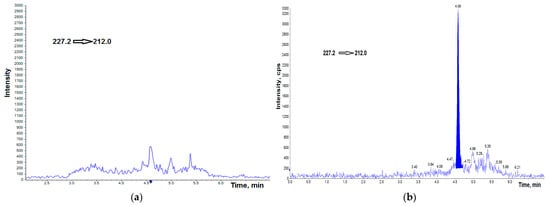
Figure 1.
UHPLC–MS/MS chromatogram of BPA-free HA (a), BPA-free HA spiked with 0.25 ng g−1 BPA (b). cps—counts per second.
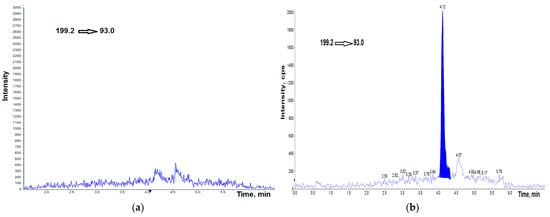
Figure 2.
UHPLC–MS/MS chromatogram of BPF-free HA (a), BPF-free HA spiked with 0.25 ng g−1 BPF (b). cps—counts per second.
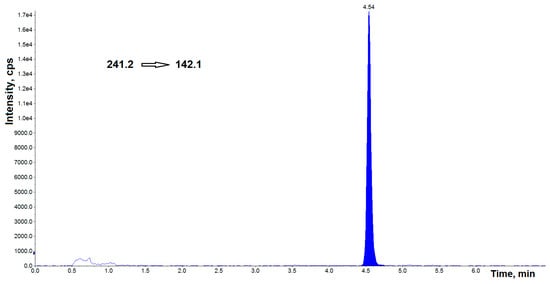
Figure 3.
UHPLC–MS/MS chromatogram of bisphenol A-d16 (IS) at concentration of 2.5 ng mL−1. cps—counts per second.
Fragmentation of BPA in the mass spectrometer showed two main product ions (fragments m/z 133, and 212) at m/z 227.2 as the precursor ion. Therefore, these MRM transitions were chosen to identification BPA in AH samples. These product ions have been previously used to quantify BPA by MS analysis [76,77,78] as ions with relatively higher abundance.
3.2. Validation Protocol
A procedure based on UHPLC-MS/MS has been developed and validated for the quantification of BPA and PBF in AH. The isotope labeled BPA (bisphenol–D16) internal standard added at the stage of sample preparation, ensured improvement of the precision and accuracy of the quantitative determination due to eliminating the matrix effect, effects related to loss of analyte, or different sample volumes [79].
Representative chromatograms obtained by spiking BPA-free, and BPF-free AH by the standards at a concentration of 0.25 ng mL−1 are shown in Figure 1a,b and Figure 2a,b, respectively. Figure 3 shows the chromatogram of the internal standard.
Quantification of target analytes were investigated by an internal standard method at five concentration points. Linear calibration curves showed determination coefficients (R2) equal to or higher than 0.98 in all cases. The limit of detection (LOD) and the limit of quantification (LOQ) values were adequate for the purpose of the present study (Table 3). The intra- and inter-assay precision and recovery were in accordance with the internationally established acceptance criteria. The calculated RSD% for repeatability and reproducibility showed values that were always lower than 5% (Table 4).

Table 3.
Parameters obtained for the calibration curves for BPA and BPF.

Table 4.
Intra-assay (n = 6) and inter-assay (n = 18) precision, and % recovery of BPA I BPF.
3.3. Concentrations of BPs in AH Samples
The AH samples taken from 44 Polish participants undergoing cataract surgery were collected and analyzed. Three peaks were resolved in the MRM transition m/z 227.2/212. This indicates that instead of BPA, two of its structural isomers existed in the AH samples, and were labeled BPA-1, and BPA-2 in increasing order of retention time. The compound eluted at a retention time of 4.58 min was BPA, which was confirmed using the BPA standard. BPA isomers were identified when at least two selected MRM transitions responded at the same retention time. Two additional peaks observed, exhibited the same fragment pathways as BPA, and they both showed m/z 227.2/133, and 227.2/212 fragments. Representative UHPLC–MS/MS chromatograms are shown in the Figure 4.
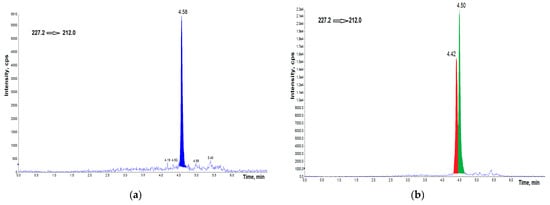
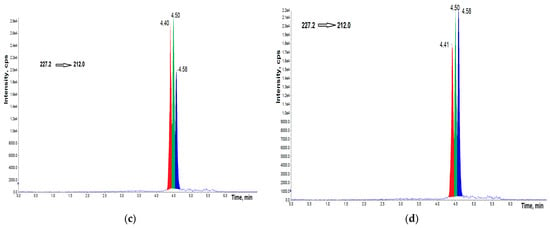
Figure 4.
UHPLC–MS/MS chromatogram of AH samples with detected BPA (a), AH sample with two detected isomers of BPA (b), AH sample with detected BPA and two isomers (c), AH sample with BPA and two detected isomers and spiked with 2.0 ng g−1 of BPA (d). cps—counts per second.
The raw data for the male/female cataract subjects with/without coexisting ophthalmic pathology is presented in Supplementary Table (Table S1). Around 40% of collected whole AH samples contained detectable BPA-1 (red) and BPA-2 (green) (Table 5). More precisely BPA was detected in 12 AH samples (27.27%), with mean concentrations of 1.39 ng/g. BPF was not detected at all. The structural isomers of BPA (BPA-1, BPA-2) were identified in 18 samples (40.91%), for the first time in AH, at mean concentrations of 2.15 ng/mL and 2.25 ng/mL, respectively. The concentration profiles of ∑BPs (sum of BPA-1, BPA-2, BPA) in AH samples is shown in Figure 5. The graph shows only these subjects exhibited any presence of BPs.

Table 5.
Descriptive statistics for UHPLC–MS/MS measurements of AH samples taken from the entire population of the studied subjects (n = 44).
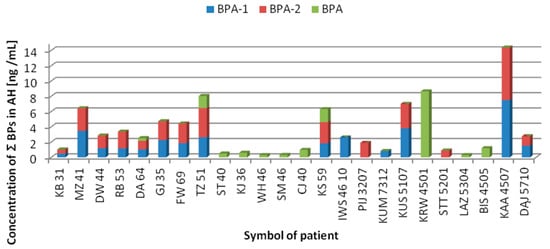
Figure 5.
Stacked bar charts dividing each bar into subcategories representing the concentration of BPA-free, and its structural isomers BPA-1, BPA-2 in AH of patients undergoing cataract surgery.
3.4. Comparison between the Specific Groups
All clinical samples have been divided into different groups: one group included patients with cataracts and the second one with cataracts and coexisting ocular diseases like AMD, glaucoma, and the third one with coexisting diabetes. Furthermore, we compared males and females in order to determine whether there is statistical evidence that the associated populations are significantly different according to total BPs content in AH samples.
In the group of women (F), a clear right-sided asymmetry was observed, therefore the Mann–Whitney test was used to compare selected groups by gender. Descriptive statistics for the male and female groups are presented in Table 6, and Figure 6. A higher median value of BPs concentration (2.21 ng mL−1) was found in the group of men compared to the group of women (0.41 ng mL−1). However, obtained correlation did not achieve a statistical significance level of p = 0.09 (p > 0.05).

Table 6.
Descriptive statistics for female and male groups.
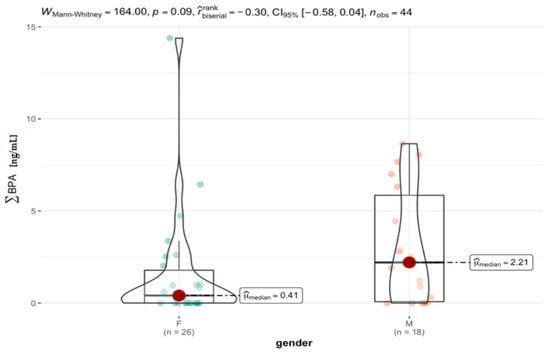
Figure 6.
Statistical significance of differences in total BPs content in AH samples of females (F) and males (M).
The statistical analysis relating to the comparison of the cataract group with the group of patients with additional ocular pathologies, i.e., cataract, glaucoma, and AMD, is presented in Table 7 and Figure 7. Also, in this case, it can be noticed that while the median value is much higher for the group with cataract and coexisting eye diseases (1.90 ng/mL) compared to the cataract group (0.5 ng/mL), the difference between these groups did not reach statistical significance (p = 0.18).

Table 7.
Descriptive statistics for cataract group and cataract with coexisting ocular pathologies (glaucoma, AMD) group.
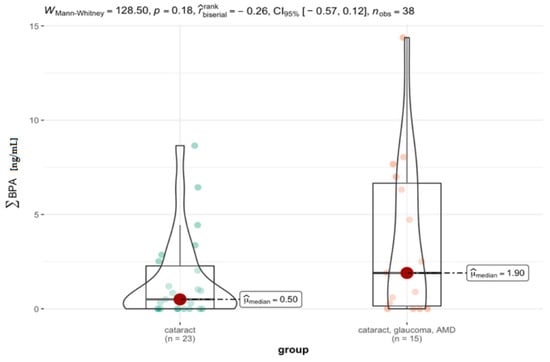
Figure 7.
Statistical significance of differences in BPs’ content in AH for cataract and cataract with coexisting ocular pathologies (AMD, glaucoma).
Including diabetes as an additional disease showed differences in median values but did not change the statistical significance of the compared groups (p > 0.05) (Table 8, Figure 8).

Table 8.
Descriptive statistics for cataract group and cataract with coexisting ocular pathologies (glaucoma, AMD) and diabetes.
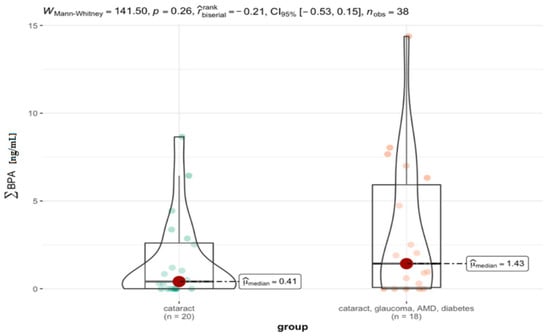
Figure 8.
Statistical significance of differences in BPs’ content in AH for cataract and cataract with coexisting ocular pathologies (AMD, glaucoma) and diabetes.
To compare two independent data sets coming from distinct populations, which do not affect each other, the Mann–Whitney test being the nonparametric counterpart of the t-Student test, has been applied. Obtained values of p indicate that there were differences in the median values regarding the level of total BPs in AH samples. but they were not statistically significant. The total content of BPs was higher in patients with coexisting ocular diseases (glaucoma and AMD) and diabetes in comparison to cataracts alone. It should be emphasized that nonparametric tests such as the Mann–Whitney test have poor discriminatory power. Therefore, we cannot exclude the possibility that the results could turn out significant if replicated with a larger cohort group.
4. Discussion
Our study is the first to measure BPs in human AH samples and the first to show the presence of free BPA, as well as two of its structural isomers, assigned as BPA-1 and BPA-2. Although it is already known that BPA exists in the form of several structural isomers, identified as by-products in industrial production, only a few studies described the occurrence of BPA isomers in samples of human origin. The first report on the occurrence of BPA isomers tentatively termed B1-4-BPA was published in 2022 by Li et al. [80]. The authors also analyzed three BPA metabolites such as BPA-sulfate, BPA-glucuronide, and BPA- bisulfate disodium salt. The method used in this study, however, required a multi-step sample preparation procedure to enable the analysis of human serum and whole blood by UHPLC-MS/MS.
In our study, not even one form of BPA was detected in about 1/3 of the respondents. It is very difficult to indicate the reasons why BPs are detected in some individuals while others do not have them at all. To explain this, it would be necessary to know what the exposure to BPs was or conduct more extensive examinations of the health of patients with the aim of pointing out any metabolic differences between them. In our opinion, this stage of research should be transferred to animal experiments, where it is possible to systematically monitor the BPs’ exposure or the activity of key enzymes. It is worth noticing that the levels of BPA isomers were approximately two times higher in comparison to BPA. Patients undergoing cataract surgery usually suffered from additional diseases such as diabetes, hypertension, glaucoma, and AMD. The BPs detected in AH seem to be only one of the environmental factors contributing to the deterioration of their health. It should be emphasized, however, that patients who, in addition to cataracts, suffered from other ocular diseases such as AMD, and glaucoma, or diabetes had higher mean total levels of BPs. The men’s group was also characterized by elevated total levels of BPs concentration in AH samples in comparison to the women’s group.
Demonstrating the presence of BPA in AH seems to be important from the point of view of many potential threats related to BPs intoxication starting from direct oxidative damage [81], changing the activity of many enzymes [82,83,84,85,86,87,88,89,90,91], deregulation of the gene expression [55,92], up to the increase in pro-inflammatory cytokines [93], and apoptotic proteins [94].
BPA can work by changing the activity of many enzymes, including the increase in the activity of the angiotensin-converting enzyme (ACE), i.e., the HBP marker [82,83]. It is known that arterial hypertension causes abnormal blood flow and, consequently, visual disturbances and retinal damage, related to the development of hypertensive retinopathy [84], which predisposes to the development of cataracts. BPA works not only through the renin–angiotensin–aldosterone system (RAAS), but also by blocking the activity of ocular endothelial nitric oxide synthase (eNOS) [85]. NO is a key molecule that has the ability to dilate blood vessels and regulate microcirculation. Decreased NOS expression has been associated with the development of hypertensive retinopathy, cataracts, glaucoma, vitreous hemorrhage [86], and the cell proliferation (hyperplasia) of ocular cancer and degeneration of retinocyte outgrowth, with the deterioration of conjunctiva and lens [87]. Another enzyme that is associated with BPA intoxication is arginase, the increased expression of which can trigger inflammatory processes [88] that lead to the development of cataracts. Another enzyme whose activity increases under the influence of BPA is phosphodiesterase-5 (PDE-5). PDE-5 breaks down cyclic guanylate monophosphate (cGMP) necessary for the relaxation of optical vessels. Thus, an increase in PDE-5 activity causes endothelial dysfunction of the eye. The increase in the activity of acetylcholinesterase (AChE), butyrylcholinesterase (BuChE) and monoamine oxidase-A (MAO-A) is also responsible for the occurrence of HBP and an increased risk of developing ocular hypertension and related complications. It has been observed that the decreased activity of NOS after exposure to BPA also increases the hydrolysis of ATP by the enzymes ATPase, ADPase, AMPase and the activity of adenosine deaminase (ADA) in the eye cells in arterial hypertension in rats [89]. It is particularly dangerous for the development of oculopathy and the predisposition to ischemic injury to the optic nerves [90]. It should be emphasized that intracellular adenosine has been described as an endothelial-derived hyperpolarization factor due to the ability to relax and hyperpolarize vessels smoothing the muscle cells [91]. A study by Akintunde, et al. [55] shows that exposure to BPA increases the expression of the CD43 gene in the eye, which regulates T-cell function. This fact indicates that BPA interferes with the immune function of the eyes [92]. BPA also increases the expression of pro-inflammatory cytokines (tumor necrosis factor TNF-α., interleukins, IL-1ß) which are involved in oncogenesis and cause cell inflammation [93], damage to the cornea, lacrimal gland, retinopathy, and dry keratoconjunctivitis (KCS). BPA intoxication increases the level of apoptotic proteins, including caspase-9, in the eye of rats, which suggests an increased risk of developing eye cancer following eye trauma [94]. There is also a danger that an increase in caspase-9 expression with low NO levels in retinocytes, activating cGMP hydrolysis, may induce degeneration upon exposure to ultraviolet B radiation [95]. Also, the transcription of the gene encoding P53 (tumor protein) increases after exposure to BPA [96].
Moreover, it should be remembered that BPA is primarily a xenoestrogen. Considering the fact that estrogen receptors (ERs) are also located in the nodes of the visual pathway, such as the retina [97,98] and the primary visual cortex [99], BPA, even in low doses can affect the functioning of the eye by antagonizing estrogenic functions [100].
Simultaneous exposure to BPA and its isomers complicates the prediction of potential hazards. To our knowledge, there is still no data concerning isomers’ toxicity therefore we are not able to predict their influence on the vision organ. Data on isomers should therefore be required in the assessment of exposure to BPs, especially as they occur at almost twice the concentration level.
5. Conclusions
The BPs (BPA, and BPF) are the most commonly applied chemical plasticizers used in the production of plastics to enhance their rigidity. Our preliminary study reports the presence of BPA and its isomers in AH of patients undergoing cataract surgery. The validated UHPLC–MS/MS method was applied for the quantification of the analytes. BPA was detected in only some samples, whereas the presence of BPF at a level higher than the detection limit was not confirmed. Besides BPA, its two structural isomers tentatively named BPA-1, and BPA-2 at almost two times higher concentrations in comparison to BPA, were found. The considerable amount of BPs from a few to several ng per mL of AH may represent the degree of exposure of human eyes to these environmental toxins.
Confirmed accumulation of BPs in AH may be the real threat to the proper function of the visual organs, especially since the total concentration of BPs in AH of patients suffering from cataracts and coexisting diseases was higher in comparison to cataract patients. Our research shows that men are more likely to accumulate BPs. In view of the potential risks outlined in the discussion, there is a dire need to continue the research in a larger patient population to shed new light on BPA-induced ocular dysfunctions.
Supplementary Materials
The following supporting information can be downloaded at: https://www.mdpi.com/article/10.3390/jcm11216402/s1. Table S1: The raw data for the male (m)/female (w) cataract individuals with and/or without coexisting ophthalmic pathology (AMD, glaucoma) represented by mean concentration [ng mL−1] of BPA-1, BPA-2, BPA-free, and ΣBPS. The measurements of BPs concentration were performed by UHPLC-MS/MS. Conditions of measurements were described in Section 2.4.
Author Contributions
Conceptualization, J.F., R.R. and J.D.-S.; methodology, T.Ś.; software, J.F. and T.Ś.; validation, T.Ś.; formal analysis, T.Ś.; investigation, T.Ś.; resources, J.D.-S.; data curation, J.F.; writing—original draft preparation, J.F.; writing—review and editing, J.F.; visualization, J.F.; supervision, R.R.; project administration, W.Z.; funding acquisition, W.Z. All authors have read and agreed to the published version of the manuscript.
Funding
This research received no external funding.
Institutional Review Board Statement
The study was conducted in accordance with the Declaration of Helsinki, and approved by the Institutional Ethics Committee of Medical University of Lublin (protocol code KE-0254/154/06/2022 and date of approval—30 June 2022).
Informed Consent Statement
Informed consent was obtained from all subjects involved in the study.
Data Availability Statement
Not applicable.
Conflicts of Interest
The authors declare no conflict of interest.
References
- Caprioli, J. The ciliary epithelia and aqueous humor. In Adler’s Physiology of the Eye: Clinical Application, 9th ed.; Adler, F.H., Hart, W.M., Eds.; Mosby Year Book: St. Louis, MO, USA, 1992. [Google Scholar]
- Gum, G.G.; Gelatt, K.N.; Esson, D.W. Physiology of the eye. In Veterinary Ophthalmology, 4th ed.; Gelatt, K.N., Ed.; Blackwell Pub.: Ames, IA, USA, 2007. [Google Scholar]
- Biros, D.J. Immunology and the Eye. In Veterinary Ophthalmology, 4th ed.; Gelatt, K.N., Ed.; Blackwell Pub.: Ames, IA, USA, 2007. [Google Scholar]
- Kim, T.W.; Kang, J.W.; Ahn, J.; Lee, E.K.; Cho, K.C.; Han, B.N.; Hong, N.Y.; Park, J.; Kim, K.P. Proteomic analysis of the aqueous humor in age-related macular degeneration (AMD) patients. J. Proteome Res. 2012, 11, 4034–4043. [Google Scholar] [CrossRef] [PubMed]
- Kaur, I.; Kaur, J.; Sooraj, K.; Goswami, S.; Saxena, R.; Chauhan, V.S.; Sihota, R. Comparative evaluation of the aqueous humor proteome of primary angle closure and primary open angle glaucomas and age-related cataract eyes. Int. Ophthalmol. 2019, 39, 69–104. [Google Scholar] [CrossRef] [PubMed]
- Flieger, J.; Dolar-Szczasny, J.; Rejdak, R.; Majerek, D.; Tatarczak-Michalewska, M.; Proch, J.; Blicharska, E.; Flieger, W.; Baj, J.; Niedzielski, P. The Multi-Elemental Composition of the Aqueous Humor of Patients Undergoing Cataract Surgery, Suffering from Coexisting Diabetes, Hypertension, or Diabetic Retinopathy. Int. J. Mol. Sci. 2021, 22, 9413. [Google Scholar] [CrossRef] [PubMed]
- Ji, Y.; Rong, X.; Lu, Y. Metabolic characterization of human aqueous humor in the cataract progression after pars plana vitrectomy. BMC Ophthalmol. 2018, 18, 63. [Google Scholar] [CrossRef]
- Miric, D.; Kisic, B.; Zoric, L.; Miric, B.M.; Mirkovic, M.; Mitic, R. Influence of cataract maturity on aqueous humor lipid peroxidation markers and antioxidant enzymes. Eye 2014, 28, 72–77. [Google Scholar] [CrossRef]
- Flieger, J.; Święch-Zubilewicz, A.; Śniegocki, T.; Dolar-Szczasny, J.; Pizoń, M. Determination of Tryptophan and Its Major Metabolites in Fluid from the Anterior Chamber of the Eye in Diabetic Patients with Cataract by Liquid Chromotography Mass Spectrometry (LC-MS/MS). Molecules 2018, 23, 3012. [Google Scholar] [CrossRef]
- Chowdhury, U.R.; Madden, B.J.; Charlesworth, M.C.; Fautsch, M.P. Proteome analysis of human aqueous humor. Investig. Ophthalmol. Vis. Sci. 2010, 51, 4921–4931. [Google Scholar] [CrossRef]
- Dolar-Szczasny, J.; Święch, A.; Flieger, J.; Tatarczak-Michalewska, M.; Niedzielski, P.; Proch, J.; Majerek, D.; Kawka, J.; Mackiewicz, J. Levels of Trace Elements in the Aqueous Humor of Cataract Patients Measured by the Inductively Coupled Plasma Optical Emission Spectrometry. Molecules 2019, 24, 4127. [Google Scholar] [CrossRef]
- Dolar-Szczasny, J.; Flieger, J.; Kowalska, B.; Majerek, D.; Tatarczak-Michalewska, M.; Zakrocka, I.; Załuska, W.; Rejdak, R. Hemodialysis Effect on the Composition of the Eye Fluid of Cataract Patients. J. Clin. Med. 2021, 10, 5485. [Google Scholar] [CrossRef]
- Fenichel, P.; Chevalier, N.; Brucker-Davis, F. Bisphenol A: An endocrine and metabolic disruptor. Ann. Endocrinol. 2013, 74, 211–220. [Google Scholar] [CrossRef]
- Careghini, A.; Mastorgio, A.F.; Saponaro, S.; Sezenna, E. Bisphenol A, nonylphenols, benzophenones, and benzotriazoles in soils, groundwater, surface water, sediments, and food: A review. Environ. Sci. Pollut. Res. Int. 2015, 22, 5711–5741. [Google Scholar] [CrossRef] [PubMed]
- Makinwa, T.; Uadia, P. A survey of the level of bisphenol A (BPA) in effluents soil leachates, food samples, drinking water and consumer products in south western Nigeria. World Environ. 2015, 5, 135–139. [Google Scholar] [CrossRef]
- Wang, H.; Chang, L.; Aguilar, J.S.; Dong, S.; Hong, Y. Bisphenol-A exposure induced neurotoxicity in glutamatergic neurons derived from human embryonic stem cells. Environ. Int. 2019, 127, 324–332. [Google Scholar] [CrossRef] [PubMed]
- Stahlhut, R.W.; Welshons, W.V.; Swan, S.H. Bisphenol A data in Stahlhut RW, Welshons WV, Swan SH. Bisphenol A data in NHANES suggest longer than expected half-life, substantial nonfood exposure, or both. Environ. Health Perspect. 2009, 117, 784–789. [Google Scholar] [CrossRef]
- Elsworth, J.D.; Jentsch, J.D.; Groman, S.M.; Roth, R.H.; Redmond, E.D., Jr.; Leranth, C. Low circulating levels of bisphenol-A induce cognitive deficits and loss of asymmetric spine synapses in dorsolateral prefrontal cortex and hippocampus of adult male monkeys. J. Comp. Neurol. 2015, 523, 1248–1257. [Google Scholar] [CrossRef]
- Wang, C.; Li, Z.; Han, H.; Luo, G.; Zhou, B.; Wang, S.; Wang, J. Impairment of object recognition memory by maternal bisphenol A exposure is associated with inhibition of Akt and ERK/CREB/BDNF pathway in the male offspring hippocampus. Toxicology 2016, 341–343, 56–64. [Google Scholar] [CrossRef]
- Yoshimura, Y.; Brock, J.W.; Makino, T.; Nakazawa, H. Measurement of bisphenol A in human serum by gas chromatography/mass spectrometry. Anal. Chim. Acta 2002, 458, 331–336. [Google Scholar] [CrossRef]
- Wan, H.T.; Leung, P.Y.; Zhao, Y.G.; Wei, X.; Wong, M.H.; Wong, C.K.C. Blood plasma concentrations of endocrine disrupting chemicals in Hong Kong populations. J. Hazard. Mater. 2013, 261, 763–769. [Google Scholar] [CrossRef]
- Kosarac, I.; Kubwabo, C.; Lalonde, K.; Foster, W. A novel method for the quantitative determination of free and conjugated bisphenol A in human maternal and umbilical cord blood serum using a two-step solid phase extraction and gas chromatography/tandem mass spectrometry. J. Chromatogr. B Analyt. Technol. Biomed. Life Sci. 2012, 898, 90–94. [Google Scholar] [CrossRef]
- Kim, A.; Li, C.R.; Jin, C.F.; Lee, K.W.; Lee, S.H.; Shon, K.J.; Park, N.G.; Kim, D.K.; Kang, S.W.; Shim, Y.B.; et al. A sensitive and reliable quantification method for Bisphenol A based on modified competitive ELISA method. Chemosphere 2007, 68, 1204–1209. [Google Scholar] [CrossRef]
- Kandaraki, E.; Chatzigeorgiou, A.; Livadas, S.; Palioura, E.; Economou, F.; Koutsilieris, M.; Palimeri, S.; Panidis, D.; Diamanti-Kandarakis, E. Endocrine disruptors and polycystic ovary syndrome (PCOS): Elevated serum levels of bisphenol A in women with PCOS. J. Clin. Endocrinol. Metab. 2011, 96, E480–E484. [Google Scholar] [CrossRef] [PubMed]
- Groshart, C.; Okkerman, P.; Pijnenburg, A. Chemical Study on Bisphenol A; RIKZ/1001.027; Rijkswaterstaad, RIKZ: Utrecht, The Netherlands, 2001. [Google Scholar]
- Aristiaawan, Y.; Aryana, N.P.D.; Styarini, D. Analytical Method Development for Bisphenol A in Tuna by Using High Performance Liquid Chromatography-UV. Procedia Chem. 2015, 16, 202–208. [Google Scholar] [CrossRef]
- Kuroda, N.; Kinoshita, Y.; Sun, Y.; Wada, M.; Kishikawa, N.; Nakashima, K.; Makino, T.; Nakazawa, H. Measurement of bisphenol A levels in human blood serum and ascitic fluid by HPLC using a fluorescent labeling reagent. J. Pharm. Biomed. Anal. 2003, 30, 1743–1749. [Google Scholar] [CrossRef]
- Inoue, K.; Kato, K.; Yoshimura, Y.; Makino, T.; Nakazawa, H. Determination of bisphenol A in human serum by high-performance liquid chromatography with multi-electrode electrochemical detection. J. Chromatogr. B Biomed. Sci Appl. 2000, 749, 17–23. [Google Scholar] [CrossRef]
- Khedr, A. Optimized extraction method for LC-MS determination of bisphenol A, melamine and di(2-ethylhexyl) phthalate in selected soft drinks, syringes, and milk powder. J. Chromatogr. B Analyt. Technol. Biomed. Life Sci. 2013, 930, 98–103. [Google Scholar] [CrossRef]
- Alabi, A.; Caballero-Casero, N.; Rubio, S. Development and validation of a stable-isotope dilution liquid chromatography–tandem mass spectrometry method for the determination of bisphenols in ready-made meals. J. Chromatogr. A. 2014, 1336, 23–33. [Google Scholar] [CrossRef]
- Cobellis, L.; Colacurci, N.; Trabucco, E.; Carpentiero, C.; Grumetto, L. Measurement of bisphenol A and bisphenol B levels in human blood sera from healthy and endometriotic women. Biomed. Chromatogr. 2009, 23, 1186–1190. [Google Scholar] [CrossRef]
- Gyllenhammar, I.; Tröger, R.; Glynn, A.; Rosén, J.; Hellenäs, K.E.; Lignell, S. Serum levels of unconjugated bisphenol A are below 0.2ng/ml in Swedish nursing women when contamination is minimized. Environ. Int. 2014, 64, 56–60. [Google Scholar] [CrossRef]
- Servaes, K.; Voorspoels, S.; Lievens, J.; Noten, B.; Allaerts, K.; Van De Weghe, H.; Vanermen, G. Direct analysis of phthalate ester biomarkers in urine without preconcentration: Method validation and monitoring. J. Chromatogr. A. 2013, 1294, 25–32. [Google Scholar] [CrossRef]
- Geens, T.; Bruckers, L.; Covaci, A.; Schoeters, G.; Fierens, T.; Sioen, I.; Vanermen, G.; Baeyens, W.; Morrens, B.; Loots, I.; et al. Determinants of bisphenol A and phthalate metabolites in urine of Flemish adolescents. Environ. Res. 2014, 134, 110–117. [Google Scholar] [CrossRef]
- Provencher, G.; Bérubé, R.; Dumas, P.; Bienvenu, J.F.; Gaudreau, E.; Bélanger, P.; Ayotte, P. Determination of bisphenol A, triclosan and their metabolites in human urine using isotope-dilution liquid chromatography-tandem mass spectrometry. J. Chromatogr. A. 2014, 1348, 97–104. [Google Scholar] [CrossRef]
- Zhou, X.; Kramer, J.P.; Calafat, A.M.; Ye, X. Automated on-line column-switching high performance liquid chromatography isotope dilution tandem mass spectrometry method for the quantification of bisphenol A, bisphenol F, bisphenol S, and 11 other phenols in urine. J. Chromatogr. B Analyt. Technol. Biomed. Life Sci. 2014, 944, 152–156. [Google Scholar] [CrossRef] [PubMed]
- Ye, X.; Kuklenyik, Z.; Needham, L.L.; Calafat, A.M. Measuring environmental phenols and chlorinated organic chemicals in breast milk using automated on-line column-switching-high performance liquid chromatography-isotope dilution tandem mass spectrometry. J. Chromatogr. B Analyt. Technol. Biomed. Life Sci. 2006, 831, 110–115. [Google Scholar] [CrossRef] [PubMed]
- Azzouz, A.; Rascón, A.J.; Ballesteros, E. Simultaneous determination of parabens, alkylphenols, phenylphenols, bisphenol A and triclosan in human urine, blood and breast milk by continuous solid-phase extraction and gas chromatography-mass spectrometry. J. Pharm. Biomed. Anal. 2016, 119, 16–26. [Google Scholar] [CrossRef] [PubMed]
- Buscher, B.; van de Lagemaat, D.; Gries, W.; Beyer, D.; Markham, D.A.; Budinsky, R.A.; Dimond, S.S.; Nath, R.V.; Snyder, S.A.; Hentges, S.G. Quantitative analysis of unconjugated and total bisphenol A in human urine using solid-phase extraction and UPLC-MS/MS: Method implementation, method qualification and troubleshooting. J. Chromatogr. B Analyt. Technol. Biomed. Life Sci. 2015, 1005, 30–38. [Google Scholar] [CrossRef] [PubMed][Green Version]
- Yazdinezhad, S.R.; Ballesteros-Gómez, A.; Lunar, L.; Rubio, S. Single-step extraction and cleanup of bisphenol A in soft drinks by hemimicellar magnetic solid phase extraction prior to liquid chromatography/tandem mass spectrometry. Anal. Chim. Acta 2013, 778, 31–37. [Google Scholar] [CrossRef]
- Li, Y.; Zhang, S.; Song, C.; You, J. Determination of Bisphenol A and Alkylphenols in Soft Drinks by High-Performance Liquid Chromatography with Fluorescence Detection. Food Anal. Method 2013, 6, 1284–1290. [Google Scholar] [CrossRef]
- Cunha, S.C.; Cunha, C.; Ferreira, A.R.; Fernandes, J.O. Determination of bisphenol A and bisphenol B in canned seafood combining QuEChERS extraction with dispersive liquid-liquid microextraction followed by gas chromatography-mass spectrometry. Anal. Bioanal. Chem. 2012, 404, 2453–2463. [Google Scholar] [CrossRef]
- Tuzimski, T.; Szubartowski, S. Application of Solid-Phase Extraction and High-Performance Liquid Chromatography with Fluorescence Detection to Analyze Eleven Bisphenols in Amniotic Fluid Samples Collected during Amniocentesis. Int. J. Environ. Res. Public Health 2022, 19, 2309. [Google Scholar] [CrossRef]
- Philippat, C.; Wolff, M.S.; Calafat, A.M.; Ye, X.; Bausell, R.; Meadows, M.; Stone, J.; Slama, R.; Engel, S.M. Prenatal exposure to environmental phenols: Concentrations in amniotic fluid and variability in urinary concentrations during pregnancy. Environ. Health Perspect. 2013, 121, 1225–1231. [Google Scholar] [CrossRef]
- Zhang, B.; He, Y.; Zhu, H.; Huang, X.; Bai, X.; Kannan, K.; Zhang, T. Concentrations of bisphenol A and its alternatives in paired maternal–fetal urine, serum and amniotic fluid from an e-waste dismantling area in China. Environ. Int. 2020, 136, 105407. [Google Scholar] [CrossRef] [PubMed]
- Tuzimski, T.; Szubartowski, S. Method Development for Selected Bisphenols Analysis in Sweetened Condensed Milk from a Can and Breast Milk Samples by HPLC–DAD and HPLC-QqQ-MS: Comparison of Sorbents (Z-SEP, Z-SEP Plus, PSA, C18, Chitin and EMR-Lipid) for Clean-Up of QuEChERS Extract. Molecules 2019, 24, 2093. [Google Scholar] [CrossRef] [PubMed]
- Karnam, S.S.; Ghosh, R.C.; Mondal, S.; Mondal, M. Evaluation of subacute bisphenol—A toxicity on male reproductive system. Vet. World 2015, 8, 738–744. [Google Scholar] [CrossRef] [PubMed]
- Wang, N.; Zhou, Y.; Fu, C.; Wang, H.; Huang, P.; Wang, B.; Su, M.; Jiang, F.; Fang, H.; Zhao, Q.; et al. Influence of Bisphenol A on Thyroid Volume and Structure Independent of Iodine in School Children. PLoS ONE 2015, 10, e0141248. [Google Scholar] [CrossRef] [PubMed]
- Teppala, S.; Madhavan, S.; Shankar, A. Bisphenol A and Metabolic Syndrome: Results from NHANES. Int. J. Endocrinol. 2012, 2012, 598180. [Google Scholar] [CrossRef]
- Han, C.; Hong, Y.C. Bisphenol A, Hypertension, and Cardiovascular Diseases: Epidemiological, Laboratory, and Clinical Trial Evidence. Curr. Hypertens. Rep. 2016, 18, 11. [Google Scholar] [CrossRef]
- USEPA-IRIS; Bisphenol, A. Fuseaction Ľiris.Show Quickview & Substance_nmbrĽ0356. Available online: http://cfpub.epa.gov/ncea/iris/index.cfm? (accessed on 26 October 1988).
- Gyllenhammar, I.; Glynn, A.; Darnerud, P.O.; Lignell, S.; van Delft, R.; Aune, M. 4-Nonylphenol and bisphenol A in Swedish food and exposure in Swedish nursing women. Environ. Int. 2012, 43, 21–28. [Google Scholar] [CrossRef]
- Toxicological and Health Aspects of Bisphenol A, Report of Joint FAO/WHO Expert Meeting 2–5 November 2010 Ottawa, Canada; World Health Organization Press: Geneva, Switzerland, 2011.
- Bae, S.; Hong, Y.C. Exposure to bisphenol A from drinking canned beverages increases blood pressure: Randomized crossover trial. Hypertension 2015, 65, 313–319. [Google Scholar] [CrossRef]
- Akintunde, J.K.; Akintola, T.E.; Hammed, M.O.; Amoo, C.O.; Adegoke, A.M.; Ajisafe, L.O. Naringin protects against Bisphenol-A induced oculopathy as implication of cataract in hypertensive rat model. Biomed. Pharmacother. 2020, 126, 110043. [Google Scholar] [CrossRef]
- Xu, G.; Hu, F.; Wang, X.; Zhang, B.; Zhou, Y. Bisphenol A exposure perturbs visual function of adult cats by remodeling the neuronal activity in the primary visual pathway. Arch. Toxicol. 2018, 92, 455–468. [Google Scholar] [CrossRef]
- Iwakura, T.; Iwafuchi, M.; Muraoka, D.; Yokosuka, M.; Shiga, T.; Watanabe, C.; Ohtani-Kaneko, R. In vitro effects of bisphenol A on developing hypothalamic neurons. Toxicology 2010, 272, 52–58. [Google Scholar] [CrossRef] [PubMed]
- Vara, H.; Onofri, F.; Benfenati, F.; Sassoè-Pognetto, M.; Giustetto, M. ERK activation in axonal varicosities modulates presynaptic plasticity in the CA3 region of the hippocampus through synapsin I. Proc. Natl. Acad. Sci. USA 2009, 106, 9872–9877. [Google Scholar] [CrossRef] [PubMed]
- ICH Topic Q 2 (R1) Validation of Analytical Procedures: Text and Methodology. Available online: http://www.ema.europa.eu/docs/en_GB/document_library/Scientific_guideline/2009/09/WC500002662.pdf (accessed on 25 June 2016).
- Pharmaceutical Quality/CMC. Guidance for Industry, Analytical Procedures and Methods Validation for Drugs and Biologics, US Department of Health and Human Services, Food and Drug Administration. Available online: http://www.fda.gov/download/drug/guidancecomplianceregulatoryinformation/.guidances/ucm386366.pdf (accessed on 25 June 2016).
- Chan, C.C.; Lam, H.; Lee, Y.C.; Zhang, X.-M. Analytical Method Validation and Instrument Performance Verification; Wiley-Interscience: New York, NY, USA, 2004. [Google Scholar]
- Konieczka, P.; Namieśnik, J. Quality Assurance and Quality Control in the Analytical Chemical Laboratory: A Practical Approach, 1st ed.; Analytical Chemistry Series; CRC Press: Boca Raton, FL, USA; Taylor and Francis Group: Milton Park/Abingdon, UK, 2009. [Google Scholar]
- Konieczka, P.; Namieśnik, J. Quality Assurance and Quality Control in the Analytical Chemical Laboratory: A Practical Approach, 2nd ed.; CRC Press: Boca Raton, FL, USA, 2018. [Google Scholar]
- Matuszewski, B.K.; Constanzer, M.L.; Chavez-Eng, C.M. Strategies for the Assessment of Matrix Effect in Quantitative Bioanalytical Methods Based on HPLC−MS/MS. Anal. Chem. 2003, 75, 3019–3030. [Google Scholar] [CrossRef] [PubMed]
- R Core Team. R: A Language and Environment for Statistical Computing; R Core Team: Vienna, Austria, 2018; Available online: https://www.R-project.org/ (accessed on 31 March 2021).
- Wickham, H. Ggplot2: Elegant Graphics for Data Analysis; Springer: New York, NY, USA, 2016; ISBN 978-3-319-24277-4. [Google Scholar]
- Patil, I. Visualizations with statistical details: The ggstatsplot approach. J. Open Source Softw. 2021, 6, 3167. [Google Scholar] [CrossRef]
- Kassambara, A. Rstatix: Pipe-Friendly Framework for Basic Statistical Tests. 2021. Available online: https://CRAN.R-project.org/package=rstatix (accessed on 13 February 2021).
- Sjoberg, D.D.; Curry, M.; Hannum, M.; Larmarange, J.; Whiting, K.; Zabor, E.C.; Drill, E.; Flynn, J.; Lavery, J.; Lobaugh, S.; et al. Gtsummary: Presentation-Ready Data Summary and Analytic Result Tables. 2021. Available online: https://CRAN.R-project.org/package=gtsummary (accessed on 21 June 2021).
- Fay, M.P.; Proschan, M.A. Wilcoxon-Mann-Whitney or t-test? On assumptions for hypothesis tests and multiple interpretations of decision rules. Stat. Surv. 2010, 4, 1–39. [Google Scholar] [CrossRef]
- Neuhäuser, M. Wilcoxon–Mann–Whitney Test. In International Encyclopedia of Statistical Science; Springer: Berlin/Heidelberg, Germany, 2011; pp. 1656–1658. [Google Scholar] [CrossRef]
- Wilczewska, K.; Namieśnik, J.; Wasik, A. Troubleshooting of the determination of bisphenol A at ultra-trace levels by liquid chromatography and tandem mass spectrometry. Anal. Bioanal. Chem. 2016, 408, 1009–1013. [Google Scholar] [CrossRef]
- Śniegocki, T. Liquid chromatography–mass spectrometry analysis of carvacrol in chicken tissues. J. Vet. Res. 2022, 66, 225–233. [Google Scholar] [CrossRef]
- Arias, J.L.O.; Schneider, A.; Andrade, J.A.B.; Vieira, A.A.; Gehrke, V.R.; Camargo, E.R.; Caldas, S.S.; Primel, E.G. Evaluation of dilute-and-shoot and solid-phase extraction methods for the determination of S-metolachlor and metolachlor-OA in runoff water samples by liquid chromatography tandem mass spectrometry. Anal. Methods 2017, 9, 5777–5783. [Google Scholar] [CrossRef]
- He, X.; Kozak, M. Simultaneous Quantitation of 43 Drugs in Human Urine with a “Dilute-and-Shoot” LC-MS/MS Method; Application Note 576; Thermo Fisher Scientific: San Jose, CA, USA, 2012. [Google Scholar]
- Liu, J.; Li, J.; Wu, Y.; Zhao, Y.; Luo, F.; Li, S.; Yang, L.; Moez, E.K.; Dinu, I.; Martin, J.W. Bisphenol A Metabolites and Bisphenol S in Paired Maternal and Cord Serum. Environ. Sci. Technol. 2017, 51, 2456–2463. [Google Scholar] [CrossRef]
- Owczarek, K.; Kubica, P.; Kudłak, B.; Rutkowska, A.; Konieczna, A.; Rachoń, D.; Namieśnik, J.; Wasik, A. Determination of trace levels of eleven bisphenol A analogues in human blood serum by high performance liquid chromatography-tandem mass spectrometry. Sci. Total. Environ. 2018, 628–629, 1362–1368. [Google Scholar] [CrossRef]
- Tan, D.; Jin, J.; Wang, L.; Zhao, X.; Guo, C.; Sun, X.; Dhanjai; Lu, X.; Chen, J. Ammonium hydroxide enhancing electrospray response and boosting sensitivity of bisphenol A and its analogs. Talanta 2018, 182, 590–594. [Google Scholar] [CrossRef] [PubMed]
- Markham, D.A.; Waechter, J.M.J.; Wimber, M.; Rao, N.; Connolly, P.; Chuang, J.C.; Hentges, S.; Shiotsuka, R.N.; Dimond, S.; Chappelle, A.H. Development of a method for the determination of bisphenol A at trace concentrations in human blood and urine and elucidation of factors influencing method accuracy and sensitivity. J. Anal. Toxicol. 2010, 34, 293–303. [Google Scholar] [CrossRef] [PubMed]
- Li, Z.; Mao, W.; Yao, L.; Zhao, N.; Zhang, Y.; Zhao, M.; Jin, H. First report on occurrence of bisphenol A isomers in human serum and whole blood. J. Hazard. Mater. 2022, 424 Pt C, 127549. [Google Scholar] [CrossRef]
- Akintunde, J.K.; Farouk, A.A.; Mogbojuri, O. Metabolic treatment of syndrome linked with Parkinson’s disease and hypothalamus pituitary gonadal hormones by turmeric curcumin in Bisphenol-A induced neuro-testicular dysfunction of wistar rat. Biochem. Biophys. Rep. 2018, 17, 97–107. [Google Scholar] [CrossRef]
- Svitok, P.; Senko, T.; Panakova, Z.; Olexova, L.; Krskova, L.; Okuliarova, M.; Zeman, M. Prenatal exposure to angiotensin II increases blood pressure and decreases salt sensitivity in rats. Clin. Exp. Hypertens. 2017, 39, 489–494. [Google Scholar] [CrossRef] [PubMed]
- Khayat, M.T.; Nayeem, M.A. The role of Adenosine A2A receptor, CYP450s, and PPARs in the regulation of vascular tone. Biomed. Res. Int. 2017, 2017, 1720920. [Google Scholar] [CrossRef]
- Brozovich, F.V.; Nicholson, C.J.; Degen, C.V.; Gao, Y.Z.; Aggarwal, M.; Morgan, K.G. Mechanisms of vascular smooth muscle contraction and the basis for pharmacologic treatment of smooth muscle disorders. Pharmacol. Rev. 2016, 68, 476–532. [Google Scholar] [CrossRef]
- Olabiyi, A.A.; Carvalho, F.B.; Bottari, N.B.; Lopes, T.F.; da Costa, P.; Stefanelo, N.; Morsch, V.M.; Akindahunsi, A.A.; Oboh, G.; Schetinger, M.R. Dietary supplementation of tiger nut alters biochemical parameters relevant to erectile function in l-NAME treated rats. Food Res. Int. 2018, 109, 358–367. [Google Scholar] [CrossRef]
- Bozkurt, B.; Okudan, N.; Belviranli, M.; Oflaz, A.B. The evaluation of intraocular pressure fluctuation in glaucoma subjects during submaximal exercise using an ocular telemetry sensor. Indian J. Ophthalmol. 2019, 67, 89–94. [Google Scholar] [CrossRef]
- Kaski, D.; Bronstein, A.M. Ocular Tremor in Parkinson’s Disease: Discussion, Debate, and Controversy. Front. Neurol. 2017, 8, 134. [Google Scholar] [CrossRef]
- Kehinde, A.J. Functional Oil from Black Seed Differentially Inhibits Aldose-reductase and Ectonucleotidase Activities by Up-regulating Cellular Energy in Haloperidol-induced Hepatic Toxicity in Rat Liver. J. Oleo. Sci. 2017, 66, 1051–1060. [Google Scholar] [CrossRef] [PubMed][Green Version]
- Kutryb-Zajac, B.; Mateuszuk, L.; Zukowska, P.; Jasztal, A.; Zabielska, M.A.; Toczek, M.; Jablonska, P.; Zakrzewska, A.; Sitek, B.; Rogowski, J.; et al. Increased activity of vascular adenosine deaminase in atherosclerosis and therapeutic potential of its inhibition. Cardiovasc. Res. 2016, 112, 590–605. [Google Scholar] [CrossRef] [PubMed]
- Guan, N.N.; Sharma, N.; Hallén-Grufman, K.; Jager, E.W.H.; Svennersten, K. The role of ATP signalling in response to mechanical stimulation studied in T24 cells using new microphysiological tools. J. Cell Mol. Med. 2018, 22, 2319–2328. [Google Scholar] [CrossRef] [PubMed]
- Akintunde, J.K.; Irondi, A.E.; Ajani, E.O.; Olayemi, T.V. Neuroprotective effect of dietary black seed flour on key enzymes linked with neuronal signaling molecules in rats exposed to mixture of environmental metals. J. Food Biochem. 2018, 42, e12573. [Google Scholar] [CrossRef]
- Velázquez, F.E.; Anastasiou, M.; Carrillo-Salinas, F.J.; Ngwenyama, N.; Salvador, A.M.; Nevers, T.; Alcaide, P. Sialomucin CD43 regulates T helper type 17 cell intercellular adhesion molecule 1 dependent adhesion, apical migration and transendothelial migration. Immunology 2019, 157, 52–69. [Google Scholar] [CrossRef]
- Mangraviti, A.; Raghavan, T.; Volpin, F.; Skuli, N.; Gullotti, D.; Zhou, J.; Asnaghi, L.; Sankey, E.; Liu, A.; Wang, Y.; et al. HIF-1α- Targeting Acriflavine Provides Long Term Survival and Radiological Tumor Response in Brain Cancer Therapy. Sci. Rep. 2017, 7, 14978. [Google Scholar] [CrossRef]
- Jukić, T.; Katusic, D.; Kordić, R.; Cacić, M.; Braunschweig, T.; Thumann, G. Malignes Melanom der Kornea nach stumpfem Trauma [Malignant melanoma of the cornea after blunt trauma]. Ophthalmologe 2009, 106, 625–627. (In German) [Google Scholar] [CrossRef]
- Tolone, A.; Belhadj, S.; Rentsch, A.; Schwede, F.; Paquet-Durand, F. The cGMP Pathway and Inherited Photoreceptor Degeneration: Targets, Compounds, and Biomarkers. Genes 2019, 10, 453. [Google Scholar] [CrossRef]
- Chtourou, Y.; Aouey, B.; Aroui, S.; Kebieche, M.; Fetoui, H. Anti-apoptotic and anti-inflammatory effects of naringin on cisplatin-induced renal injury in the rat. Chem. Biol. Interact. 2016, 243, 1–9. [Google Scholar] [CrossRef]
- Tuscher, J.J.; Luine, V.; Frankfurt, M.; Frick, K.M. Estradiol-Mediated Spine Changes in the Dorsal Hippocampus and Medial Prefrontal Cortex of Ovariectomized Female Mice Depend on ERK and mTOR Activation in the Dorsal Hippocampus. J. Neurosci. 2016, 36, 1483–1489. [Google Scholar] [CrossRef]
- Mangiamele, L.A.; Gomez, J.R.; Curtis, N.J.; Thompson, R.R. GPER/GPR30, a membrane estrogen receptor, is expressed in the brain and retina of a social fish (Carassius auratus) and colocalizes with isotocin. J. Comp. Neurol. 2017, 525, 252–270. [Google Scholar] [CrossRef] [PubMed]
- Jeong, J.K.; Tremere, L.A.; Burrows, K.; Majewska, A.K.; Pinaud, R. The mouse primary visual cortex is a site of production and sensitivity to estrogens. PLoS ONE 2011, 6, e20400. [Google Scholar] [CrossRef] [PubMed]
- Kelly, E.A.; Opanashuk, L.A.; Majewska, A.K. The effects of postnatal exposure to low-dose bisphenol-A on activity-dependent plasticity in the mouse sensory cortex. Front. Neuroanat. 2014, 8, 117. [Google Scholar] [CrossRef] [PubMed]
Publisher’s Note: MDPI stays neutral with regard to jurisdictional claims in published maps and institutional affiliations. |
© 2022 by the authors. Licensee MDPI, Basel, Switzerland. This article is an open access article distributed under the terms and conditions of the Creative Commons Attribution (CC BY) license (https://creativecommons.org/licenses/by/4.0/).